Garden Sage: Dog vomit slime; wild roaches; darkling beetles
Answers to your gardening questions from an expert in Southern Arizona.
- By Peter L. Warren Special to the Arizona Daily Star
- Updated
Question: We planted this knife acacia about eight years ago. It remains spindly and hasn’t grown as fast or lush as the previous one. (I think it succumbed to a three-day hard freeze a few years back and went to plant heaven). Do you believe it needs more/less water or should we start over? I dislike giving up on a plant that may thrive with some changes. It’s on a drip currently watering three times a week for 30 minutes, less in colder months
Answer: Your acacia might have been damaged by a frost a while ago but I see no remaining damage and this species (Acacia cultriformis, aka knife-leaf wattle) is supposed to be frost tolerant. Mostly it appears to be lacking nitrogen and/or receiving too much water according to the yellowing leaves. Actually, they’re not really leaves but rather leaf-like flattened stems called phyllodes. Since it is a plant that typically does well in arid regions, you should switch to irrigating it more deeply and less frequently. I think once every three weeks to a depth of 24 inches would be better than your current schedule. You could also apply a slow-release fertilizer to the surface around the root zone that can be watered in over time. I agree with your idea of not giving up on this plant. It’s a very nice one and worth another effort.
Peter L. Warren is the Forest Health Program coordinator for the Arizona Department of Forestry and Fire Management. Questions, photos and videos may be emailed to tucsongardensage@gmail.com
- By Peter L. Warren Special to the Arizona Daily Star
- Updated
Question: Attached are photos of this little black bug that hangs out on the ground, close to my raised lettuce garden. I haven’t seen any of them on the lettuce, but they hang out on and near the shade cloth when it’s not covering the garden. I have the shade cloth lying on the ground near the garden most of the time, and that’s when I see the bugs there. They are bigger than regular ants, and smaller than carpenter ants.
Answer: These beetles are sometimes called darkling beetles. Some species are predators of other insects while others feed on decaying plants and still others feed on stored grains. It’s hard to determine the species from your photos but I suspect these are not a pest problem based on your examination of the lettuce. To be sure, you can keep an eye on the situation and notice if your plants begin to suffer any damage.
Peter L. Warren is the Forest Health Program coordinator for the Arizona Department of Forestry and Fire Management. Questions, photos and videos may be emailed to tucsongardensage@gmail.com
- By Peter L. Warren Special to the Arizona Daily Star
- Updated
Question: We have a climbing yellow rose that we didn’t prune in January. Shall we prune now or wait until September? Shall we fertilize now or add fresh soil?
Answer: You can certainly prune off any dead or damaged canes now but leave the healthy canes. The problem with a major pruning now is that pruning is stressful to plants and the warm temperatures that have begun are as well. It’s probably best to wait until fall to do any pruning of healthy canes and then only do a light pruning, as normally recommended in the fall, and take off no more than one-third of the plant. You can do more serious pruning in the winter. Fertilizer can be applied beginning in February through May and then again in September and October. If you are spreading solid fertilizer on the soil, make sure you water before and after fertilizing to prevent burning the plants or use a water-soluble fertilizer while you are watering. You can add a half-inch of compost or other organic material to the soil surface as a slow release fertilizer and to help moderate summer temperatures in the root zone.
Peter L. Warren is the Forest Health Program coordinator for the Arizona Department of Forestry and Fire Management. Questions, photos and videos may be emailed to tucsongardensage@gmail.com
- By Peter L. Warren Special to the Arizona Daily Star
- Updated
Question: After having a compost pile for a few years, I have noticed a number of large roaches in the area and at times a greenish yellow mold grows on the top of the compost. Is there some way I can control these two problems?
Answer: Cockroaches use compost as a food source and as a place to live. The same is true for the mold you see growing on the surface. They are probably not your favorite things to see in your compost, but they are both helping to decompose the pile, so they’re not all bad. Most people dislike cockroaches that like to live in our homes although my cats love them to death. Out in the wild, cockroaches are very helpful decomposers. The yellow mold you see is sometimes affectionately known as dog vomit slime mold because that’s what it looks like when you find it. By turning your compost over more frequently, you will disturb the life cycle of both these organisms and they will be less likely to colonize the area. You will also likely speed up the process of turning your compost into something usable.
Peter L. Warren is the Forest Health Program coordinator for the Arizona Department of Forestry and Fire Management. Questions, photos and videos may be emailed to tucsongardensage@gmail.com
- By Peter L. Warren Special to the Arizona Daily Star
- Updated
Question: We saw these little bugs/insects on our friend’s orange tree in Tucson — near the Oracle and River roads area — and wondered what they were, and if harmful or not. First saw them about three weeks ago, and last saw them (not so many) about a week ago.
Answer: These insects are called thrips. They can be pests when they feed on flower, fruit and leaf buds. Their feeding causes very small damaged areas but as the flowers, leaves and fruit grow, the areas become larger and appear as discoloration or distortion on the plant surface. Typically, we don’t recommend treating for them because the damage often occurs before we notice them and they don’t affect the taste of the fruit or the ability of the leaves to photosynthesize. If you were selling your fruit to a grocery store, it would be important to spray the trees because shoppers won’t often buy fruit that have scars on the rind.
Peter L. Warren is the Forest Health Program Coordinator for the Arizona Department of Forestry and Fire Management. Questions, photos and videos may be emailed to tucsongardensage@gmail.com
- By Peter L. Warren Special to the Arizona Daily Star
- Updated
Question: I was at my doctor’s office and noticed a guy spraying pesticide on flowering plants with bees. I asked in the doctor’s office and they said the bees were flying around the door and bothering some of the patients as they came and went so they called this guy to spray the bees. Isn’t there another way to fix this besides killing the bees?
Answer: Yes, there is a way to fix it. The bees are attracted to nectar and pollen so you must remove the food source or they will return. Unfortunately, what sometimes happens is an uninformed client asks for help from a pesticide applicator that either can’t or isn’t willing to think critically about the situation. In this case, the applicator treated the symptom instead of the problem. He may have killed some bees but more will return later. Hopefully they will not continue to pay this applicator to kill more bees when they return. Pesticide applicators aren’t all this bad. Most applicators are trained to think about the entire landscape as an ecosystem and to watch out for non-target organisms, including beneficial insects like bees. This is a good teaching moment for the doctor office as well. Bees are not aggressive unless defending their home so their presence on flowers doesn’t necessarily equate to a dangerous situation. There are some pesticide applicators that are also beekeepers or at least have knowledge of bees and their behavior. I recommend seeking someone like this to deal with bee problems.
Peter L. Warren is the Forest Health Program Coordinator for the Arizona Department of Forestry and Fire Management. Questions, photos and videos may be emailed to tucsongardensage@gmail.com
- By Peter L. Warren Special to the Arizona Daily Star
- Updated
Question: I am interested in identifying this unknown garden visitor. I originally ID’d it as a native bee but after closer inspection, I am not sure if this is a bee.
Answer: Your visitor is a bee mimic sometimes called a bee fly. It is a member of the fly order (Diptera) and the family Bombyliidae. As larvae, these insects are parasites of other insects. As adults, we generally see them feeding on nectar and pollen. They can’t harm humans and are not considered to be pests.
Peter L. Warren is the Forest Health Program Coordinator for the Arizona Department of Forestry and Fire Management. Questions, photos and videos may be emailed to tucsongardensage@gmail.com
- By Peter L. Warren Special to the Arizona Daily Star
- Updated
Question: In the paper recently there was an article about blooming palo verde trees, and a claim that the reason for the bountiful flowers this year was due to additional carbon dioxide in the atmosphere. This struck me a totally ludicrous. My take is timely winter rains are the cause of bountiful flowers on any plant any year, not additional carbon dioxide!
Answer: In many plants the primary factors affecting flowering are day length, light intensity, temperature, soil moisture, and plant nutrition. Carbon dioxide in the atmosphere plays a critical role in photosynthesis and plant growth. If levels are too low, plant growth shuts down. In response to concerns about elevated carbon dioxide levels in the future associated with climate change, studies have been done to determine how these elevated levels will affect plant growth in the future. Some of this research found that plants grown at elevated carbon dioxide levels show earlier and higher production of flowers, fruits, and seeds. Keep in mind these studies were done at artificially elevated carbon dioxide levels . In the article you mentioned the quote from a local doctor said “The reason we see palo verdes become so lush is that there is more carbon dioxide in the atmosphere.”
Although we are currently experiencing the highest levels in many years, it would be difficult to show we had more flowers this year than last year based on increased levels of carbon dioxide. The more likely explanation is a combination of timely winter rains, as you mentioned, and a warm spring.
Peter L. Warren is the Forest Health Program Coordinator for the Arizona Department of Forestry and Fire Management. Questions, photos and videos may be emailed to tucsongardensage@gmail.com
- By Peter L. Warren Special to the Arizona Daily Star
- Updated
Q: I have a big mesquite tree that we planted in our front yard about 30 years ago and it has looked good except for the mistletoe, which we trim off every year.
Now the bark is peeling off. Do you know why that’s happening and is here anything we can do to stop it?
A: Bark peeling is sometimes a sign of drought. We are in the midst of a 20-plus year drought and even tough mesquites will eventually succumb to that if not given supplemental water.
This is especially true of trees in our landscapes because they are often placed in situations where they would not grow naturally.
Peter L. Warren is the Forest Health Program Coordinator for the Arizona Department of Forestry and Fire Management. Questions, photos and videos may be emailed to tucsongardensage@gmail.com
- By Peter L. Warren Special to the Arizona Daily Star
- Updated
Q: My lot in Picture Rocks has lots of creosote plants, a couple of which I need to remove for access. I was wondering, since creosote used to be a wood preserver, is it safe to chip up the branches (for me and other plants in the yard) safe to compost and so on?
A: Yes, it is safe to use creosote as a mulch or compost. Once any trees and shrubs are chipped for mulch or ground up for compost, they are organic matter like any other plant and will eventually provide a slow release nitrogen source for your garden or landscape.
In the short term, mulch is a good way to moderate temperature extremes in root zones and maintain soil moisture a bit longer than bare soil.
Peter L. Warren is the Forest Health Program Coordinator for the Arizona Department of Forestry and Fire Management. Questions, photos and videos may be emailed to tucsongardensage@gmail.com
- By Peter L. Warren Special to the Arizona Daily Star
- Updated
Q: A mesquite tree beside my driveway is getting new leaves, but I noticed a couple of dead branches among the greenery. They snapped off easily at a point where they appeared to have been neatly girdled. Does some kind of critter do that, and why?
A: Yes, the critter is commonly known as the mesquite twig girdler (Oncideres rhodostica). It is a long-horned beetle, about an inch long, that is native to our area and not considered to be a pest.
The female of the species does the girdling and then lays her eggs out beyond the girdle. The larvae feed on the nutritious cambium layer under the bark.
The nice way to think of this damage is as nature’s way of pruning your tree.
Peter L. Warren is the Forest Health Program Coordinator for the Arizona Department of Forestry and Fire Management. Questions, photos and videos may be emailed to tucsongardensage@gmail.com
- By Peter L. Warren Special to the Arizona Daily Star
- Updated
Q: Seedpods drop from trees in the parking lot in front of the Target store in Oro Valley, but we have been unable to identify what kind of trees they are. Can you help?
Answer: Your seedpods are from the Australian bottle tree (Brachychiton populneus). This is a large evergreen shade tree that can reach 60 feet in height.
These trees do well in full sun in our arid environment with sufficient water. T
he seedpods are sometimes considered messy because they decay very slowly and can be numerous on the ground.
Peter L. Warren is the Forest Health Program Coordinator for the Arizona Department of Forestry and Fire Management. Questions, photos and videos may be emailed to tucsongardensage@gmail.com
- By Peter L. Warren Special to the Arizona Daily Star
- Updated
Q: We bought what we believe to be an Arizona mesquite around April of last year. It was transplanted right away and watered about once a week, as the nursery worker said it didn’t need much water.
Fast forward to around September or October and the leaves started to turn yellow and brown. New leaves were still growing, and they were coming in green.
During the winter the leaves fell and we’re still waiting for new leaves to grow.
After checking for green under the bark and seeing if the branches snap off, it seems as though the little tree is still alive — barely. Any tips on getting it to grow or how to keep it alive?
A: It seems you took care of the tree properly although I am not sure how much water you gave it. Mesquites normally shed some leaves in the fall but they also shed leaves if they are too dry. If your tree is still bare now, it may not have received enough water.
Assuming it is still alive, the best you can do is to water it properly. That means once every two to three weeks now that the tree is established. The water should reach a depth of 24 inches and drip irrigation around the root zone is best.
Peter L. Warren is the Forest Health Program Coordinator for the Arizona Department of Forestry and Fire Management. Questions, photos and videos may be emailed to tucsongardensage@gmail.com
- By Peter L. Warren Special to the Arizona Daily Star
- Updated
Q: I planted last November in a raised planter three of these camellias. Two of the three are dying. The leaves dried from the top down. There are still some leaves alive/pliable on the bottom of the shrub. The third camellia is doing well. They get morning sun and are shaded most of the rest of the day.
My local nursery told me to deep water them, as they don’t like our soil in Tucson. I am currently continuing to water once a week but more deeply. Is there any chance of saving them at this point?
A: Camellias are not ideal plants for the desert but you can grow them if you are careful. The soil here is too alkaline for these plants so they are best grown in containers or raised beds where you can keep the soil pH on the acidic side. They also need well-drained soil with a good amount of organic matter. They don’t survive in direct sun, which may partially explain the dried leaves. Even morning sun might be too much, depending on how long they are exposed. They do better in filtered shade and protected from western exposure as you are doing. The watering advice you received is correct in the amount if the soil is drying out that quickly, although watering does nothing to affect soil pH. Plants in containers and raised beds often dry out quicker than those planted in the ground so you might need to monitor the situation more closely to determine how often to water. Small containers often need water every day.
To save your remaining plant, I recommend you make sure it is not receiving too much sun, double check the soil moisture and adjust your irrigation accordingly, and amend the soil with sulphur to lower the pH as needed. Testing your soil at a reputable lab will help determine how much sulphur to add to reach the desired pH value.
Peter L. Warren is the Forest Health Program Coordinator for the Arizona Department of Forestry and Fire Management. Questions, photos and videos may be emailed to tucsongardensage@gmail.com
- By Peter L. Warren Special to the Arizona Daily Star
- Updated
Q: For several weeks we have had what I call “golden wasps” flying around our house. On occasion two or three have made it into the house. They haven’t been aggressive, just flying around. Recently, we have noticed many of them trying to build a nest in our carport. The largest we have seen before getting rid of it has been about the size of a golf ball.
These insects have a distinctive wasp body, completely yellow (more of a golden yellow) and their wings are dark colored. We are for live-and-let-live with the wildlife in our area but we don’t think we want these guys living in the carport. Any suggestions would be most welcome.
A: Your golden wasps are paper wasps also known as Polistes flavus. They are members of the Vespidae family of wasps and not usually aggressive unless defending their nest. Their hanging paper nests are constructed each year using bits of bark and other similar material. These insects will make nests wherever they see a good site that protects their family from the environment and has nearby food sources.
It’s difficult to deter them without putting up screens to block their entrance so you might have to keep up the removal, at least in the early spring until they establish nests elsewhere. Because they nest on annual cycle the mated queens that overwintered nearby will typically stay with one nest until the end of the year, adding more cells to lay more eggs as their family grows. It’s good that you are fine with them living elsewhere because they are beneficial predators of some of our pest insects.
Peter L. Warren is the Forest Health Program Coordinator for the Arizona Department of Forestry and Fire Management. Questions, photos and videos may be emailed to tucsongardensage@gmail.com
- By Peter L. Warren Special to the Arizona Daily Star
- Updated
Q: We had a mountain laurel tree planted in March of 2016. Thought we followed the instructions for watering before leaving for Minnesota in May. While we were gone it was watered by the drip system. On our return in October the leaves were light green so took a sample to Civano Nursery and they said it showed that there was too much salt from not being watered deep enough. They recommended watering on a slow drip for ⅔ hours once a week, which we’ve been doing. The leaves are still pale green, not showing any improvement. Now we’re wondering if there’s any way to save the tree. Do you have any advice for us?
A: Given our salty soil and the salt contained in fertilizers, it is certainly possible your tree has an excess of salt in the root zone. A soil test would confirm this diagnosis but watering it deeply might confirm as well. The watering schedule they suggest is good for newly planted trees. Since your tree has been in the ground for a year, you can back it off a bit and water deeper. Established Texas mountain laurel trees should be watered deeply every two or three weeks to a depth of 24 to 36 inches to effectively wash the salt through the root zone. Because not all drip systems are created equal, it would be good to measure the water depth with a soil probe to make sure the running time is correct. A soil probe can be as simple as a piece of rebar that you push into the ground after irrigating to see how deep the water went. Dry soil will provide more resistance than the wet stuff and that’s how you will know when to pull out and measure the depth.
Peter L. Warren is the Forest Health Program Coordinator for the Arizona Department of Forestry and Fire Management. Questions, photos and videos may be emailed to tucsongardensage@gmail.com
- By Peter L. Warren Special to the Arizona Daily Star
- Updated
Q: What can we do to save the life of our beloved cactus! It started in December with some of the brown spots and now it is spreading. It has always been protected for frost with Styrofoam cups on tips and a burlap wrap. We have noticed other cacti (Mexican Fence Post) here in Saddlebrooke have the same markings. Any help would be greatly appreciated.
A: Brown spots on cacti may be caused by a few different things including too much sun on newly planted cacti, damage from animals, frost, hail, some pesticides, and diseases. The spots on your cacti appear to be fungal lesions that sometimes occur when we have cool, wet weather as we did this winter. The damage is usually cosmetic and won’t cause the death of the plant but it is also irreversible so it will remain as a scar. Now that summer-like weather has begun you should see less of this disease occurring in your neighborhood.
Q: We had a mountain laurel tree planted in March of 2016. Thought we followed the instructions for watering before leaving for Minnesota in May. While we were gone it was watered by the drip system. On our return in October the leaves were light green so took a sample to Civano Nursery and they said it showed that there was too much salt from not being watered deep enough. They recommended watering on a slow drip for ⅔ hours once a week, which we’ve been doing. The leaves are still pale green, not showing any improvement. Now we’re wondering if there’s any way to save the tree. Do you have any advice for us?
A: Given our salty soil and the salt contained in fertilizers, it is certainly possible your tree has an excess of salt in the root zone. A soil test would confirm this diagnosis but watering it deeply might confirm as well. The watering schedule they suggest is good for newly planted trees. Since your tree has been in the ground for a year, you can back it off a bit and water deeper. Established Texas mountain laurel trees should be watered deeply every two or three weeks to a depth of 24 to 36 inches to effectively wash the salt through the root zone. Because not all drip systems are created equal, it would be good to measure the water depth with a soil probe to make sure the running time is correct. A soil probe can be as simple as a piece of rebar that you push into the ground after irrigating to see how deep the water went. Dry soil will provide more resistance than the wet stuff and that’s how you will know when to pull out and measure the depth.
Peter L. Warren is the Forest Health Program Coordinator for the Arizona Department of Forestry and Fire Management. Questions, photos and videos may be emailed to tucsongardensage@gmail.com
- By Peter L. Warren Special to the Arizona Daily Star
- Updated
Q: I wrote earlier in the week about those pesky bugs that attack our Texas mountain laurel every year, and they have already started attacking this year. I am including a photo of the critter so that you might recommend something specific to get rid of them. There are too many to hand pick and they move really fast when trying to get away.
A: The critter is Uresiphita reversalis, aka the genista caterpillar. They typically feed on new growth at the ends of branches on Texas mountain laurel. I recommend a spray of Bt (Bacillus thuringiensis) where they are feeding. Bt is a naturally occurring soil bacterium that causes disease in certain insects. Bt is considered ideal for pest management because of its specificity and because of its lack of toxicity to humans or the natural enemies of many plant pests. There are different strains of Bt, each with specific toxicity to particular types of insects so be sure to choose the strain that is labeled for caterpillar pests.
Peter L. Warren is the Forest Health Program Coordinator for the Arizona Department of Forestry and Fire Management. Questions, photos and videos may be emailed to tucsongardensage@gmail.com
- Peter L. Warren Special to the Arizona Daily Star
- Updated
Q: I have a problem with deer entering our yard and eating the flowers in our patio container pots. I have tried a spray-on repellent, but it hasn’t worked. A fence is not possible. Any suggestions?
A: Fencing is the gold standard for protecting plants from deer. Otherwise, it is a bit more of a challenge. Some people use repellents with limited success because the deer either get used to the smell or the repellent wears off. If you want to try other repellents, some people hang small cloth bags with fragrant soap in them from outside branches. Others use various types of predator urine. You could also get a big dog that will bark at the deer as needed. Another tactic is to alter your landscape so the plants are difficult to access. This might be accomplished by putting the containers behind something else that blocks the deer. If there is enough other food nearby, they may see it’s too much trouble and change their route.
Peter L. Warren is the Forest Health Program Coordinator for the Arizona Department of Forestry and Fire Management. Questions, photos and videos may be emailed to tucsongardensage@gmail.com
- Peter L. Warren Special to the Arizona Daily Star
- Updated
Q: We are contemplating purchasing a home in Green Valley. There is a beautiful white oak in the front yard about 15 feet away from the home. There is a root lifting the brick pavers. How or what should I do to make sure the roots aren’t going under the foundation. Also, could I dig up that root and cut it so it doesn’t do any more damage, without hurting the tree?
A: The Arizona white oak (Quercus arizonica) is a beautiful tree, but unfortunately someone planted it too close to the house. The mature size of that species can be as wide as 50 feet. The problem you described could get worse as the tree matures. You should probably hire a certified arborist to take a look at the tree and determine the gravity of the situation. Some companies have an air spade to temporarily blow away the surface soil to get a better sense of where the roots are and which ones are expendable, if any. Some roots are critical to the stability of the tree so you wouldn’t want to cut away one that is preventing the tree from falling over.
Peter L. Warren is the Forest Health Program Coordinator for the Arizona Department of Forestry and Fire Management. Questions, photos and videos may be emailed to tucsongardensage@gmail.com
- Peter L. Warren Special to the Arizona Daily Star
- Updated
Q: I use Jobe spikes to fertilize my fruit and nut trees. Last year I fertilized in mid-February and when I went to fertilize again at the end of May, I noticed the February spikes were not used up. I use drip irrigation and put the spikes near the emitters. How long do I need to wait between refertilizing with the spikes?
A: It depends. Fertilizers in a solid spike or granular form are going to dissolve as a result of exposure to water and warm temperatures. The manufacturer typically recommends applying them at the drip line of your trees so that rain falling off the tree or drip irrigation properly installed there will help dissolve the fertilizer. If we have a cooler spring or not much winter rain, it’s possible the spikes will last longer than advertised. Also, you probably don’t need to fertilize throughout the year. Mature trees don’t need much fertilizer and they are able to get many nutrients from the soil. A late winter application will likely suffice for the year.
Peter L. Warren is the Forest Health Program Coordinator for the Arizona Department of Forestry and Fire Management. Questions, photos and videos may be emailed to tucsongardensage@gmail.com
- By Peter L. Warren Special to the Arizona Daily Star
- Updated
Q: I have an area about 15 feet by 12 feet that is bordered on two sides by sidewalk on the south side of my house. I have an 8-year-old thornless mesquite tree planted in this area. I am worried about the possibility of the roots damaging the sidewalks. Should I remove this tree? If I do, what type of tree would you recommend for that size area that would not harm the sidewalks? This area is next to my front patio and I would like to have some shade for it.
A: Thornless mesquite trees are a South American hybrid also known as the Chilean mesquite. The mature size of this tree is approximately 30 feet by 30 feet and that is only the above-ground size. The roots may spread twice as far, so your sidewalk is in jeopardy.
Small trees that could fit this space include kidneywood, Texas mountain laurel, Arizona rosewood, little leaf ash, and leather-leaf acacia. These may not give the shade you desire.
A few slightly larger trees that might fit are Texas ebony, palo blanco, and cascalote. I am sure there are others, so it would be good to visit our local nurseries to see what they have available.
Peter L. Warren is the Forest Health Program Coordinator for the Arizona Department of Forestry and Fire Management. Questions, photos and videos may be emailed to tucsongardensage@gmail.com
- By Peter L. Warren Special to the Arizona Daily Star
- Updated
Q: I have three of these in my yard, plus three that came up recently in disturbed ground. What is it?
A: Your plants are called Senna phyllodinea, or desert Senna or silver leaf cassia. It is native to Australia and does well here. It can propagate by seed. The slender silver leaves are a good desert adaptation for reflecting the sun and reducing exposure to it. They can grow into a large shrub of 6 feet by 6 feet if allowed. The fragrant yellow flowers in February are a welcome sight for many.
Peter L. Warren is the Forest Health Program Coordinator for the Arizona Department of Forestry and Fire Management. Questions, photos and videos may be emailed to tucsongardensage@gmail.com
- By Peter L. Warren Special to the Arizona Daily Star
- Updated
Q: Some of my snapdragons are covered with dark spots and it seems to be spreading to neighboring plants. What can I do to stop this problem?
A: From examining your plant sample, the problem is a disease called snapdragon rust that is caused by the fungus Puccinia antirrhini. This is a widespread pathogen that has been around since the 1800s. Small, yellow spots on the leaves are the first indication. Unless you are paying close attention, you won’t notice the yellow spots until they mature into chocolate-brown pustules. The spores that emerge from these pustules are spread by wind mostly but also possibly by rain and insects. The infection and incubation of these spores occurs best when temperatures are between 50 and 75 degrees, and that is what we have been experiencing in recent weeks.
Once temperatures exceed 90 degrees or so, the spores cannot survive. Infested plants can be removed and destroyed to reduce the immediate source of spores. There are also fungicides available to manage the rust if removing the plants isn’t in the plan. Look for products labeled for managing rust on landscape plants. Rust-resistant varieties of snapdragons are available. Planting them with space between to allow for air circulation is helpful, as is making sure to use drip irrigation rather than overhead sprinklers.
Peter L. Warren is the Forest Health Program Coordinator for the Arizona Department of Forestry and Fire Management. Questions, photos and videos may be emailed to tucsongardensage@gmail.com
- By Peter L. Warren Special to the Arizona Daily Star
- Updated
Q: I live in Tucson. Alkaline soil, lots of sun, not much rain. I have found contradictory info on fertilizing Tecomas. Local websites either say “responds well to regular fertilizer,” “fertilize with ammonium sulfate” or “this plant particularly hates (fertilizer).” Does anyone have a decisive answer from a reliable source?
A: Tecoma stans, aka yellow bells, has a reputation as a tough plant that needs little help once established, except for occasional pruning and pest management. Although I couldn’t find any research detailing its exact needs, all plants need water and nutrients.
If you want to have your soil tested by a laboratory, many of them will make fertilizer recommendations based on the results and which plants you are planning to grow. If you would rather experiment without a soil test, I recommend a slow release tree and shrub fertilizer in the spring and also recommend regularly scheduled drip irrigation every two or three weeks unless it is raining.
You can use composted manure or another organic material that has been composted as a slow-release fertilizer. In the end, your plants will help you figure out their needs by how well they appear and grow. For example, plants that begin to have yellow leaves with green veins are often showing a sign of nutrient deficiency. Taking a look at your landscape plants once a week or so to see if problems are occurring is one of the cornerstones of integrated pest management and a great way to catch problems before they get out of hand.
Peter L. Warren is the Forest Health Program Coordinator for the Arizona Department of Forestry and Fire Management. Questions, photos and videos may be emailed to tucsongardensage@gmail.com
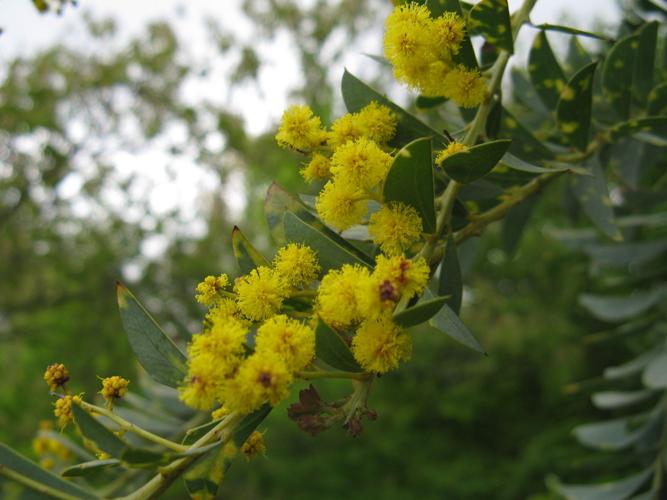
- By Peter L. Warren Special to the Arizona Daily Star
Question: We planted this knife acacia about eight years ago. It remains spindly and hasn’t grown as fast or lush as the previous one. (I think it succumbed to a three-day hard freeze a few years back and went to plant heaven). Do you believe it needs more/less water or should we start over? I dislike giving up on a plant that may thrive with some changes. It’s on a drip currently watering three times a week for 30 minutes, less in colder months
Answer: Your acacia might have been damaged by a frost a while ago but I see no remaining damage and this species (Acacia cultriformis, aka knife-leaf wattle) is supposed to be frost tolerant. Mostly it appears to be lacking nitrogen and/or receiving too much water according to the yellowing leaves. Actually, they’re not really leaves but rather leaf-like flattened stems called phyllodes. Since it is a plant that typically does well in arid regions, you should switch to irrigating it more deeply and less frequently. I think once every three weeks to a depth of 24 inches would be better than your current schedule. You could also apply a slow-release fertilizer to the surface around the root zone that can be watered in over time. I agree with your idea of not giving up on this plant. It’s a very nice one and worth another effort.
Peter L. Warren is the Forest Health Program coordinator for the Arizona Department of Forestry and Fire Management. Questions, photos and videos may be emailed to tucsongardensage@gmail.com

- By Peter L. Warren Special to the Arizona Daily Star
Question: Attached are photos of this little black bug that hangs out on the ground, close to my raised lettuce garden. I haven’t seen any of them on the lettuce, but they hang out on and near the shade cloth when it’s not covering the garden. I have the shade cloth lying on the ground near the garden most of the time, and that’s when I see the bugs there. They are bigger than regular ants, and smaller than carpenter ants.
Answer: These beetles are sometimes called darkling beetles. Some species are predators of other insects while others feed on decaying plants and still others feed on stored grains. It’s hard to determine the species from your photos but I suspect these are not a pest problem based on your examination of the lettuce. To be sure, you can keep an eye on the situation and notice if your plants begin to suffer any damage.
Peter L. Warren is the Forest Health Program coordinator for the Arizona Department of Forestry and Fire Management. Questions, photos and videos may be emailed to tucsongardensage@gmail.com
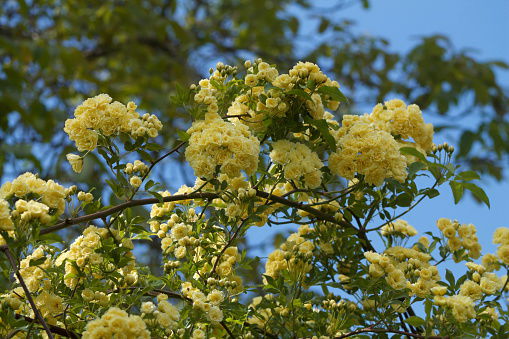
- By Peter L. Warren Special to the Arizona Daily Star
Question: We have a climbing yellow rose that we didn’t prune in January. Shall we prune now or wait until September? Shall we fertilize now or add fresh soil?
Answer: You can certainly prune off any dead or damaged canes now but leave the healthy canes. The problem with a major pruning now is that pruning is stressful to plants and the warm temperatures that have begun are as well. It’s probably best to wait until fall to do any pruning of healthy canes and then only do a light pruning, as normally recommended in the fall, and take off no more than one-third of the plant. You can do more serious pruning in the winter. Fertilizer can be applied beginning in February through May and then again in September and October. If you are spreading solid fertilizer on the soil, make sure you water before and after fertilizing to prevent burning the plants or use a water-soluble fertilizer while you are watering. You can add a half-inch of compost or other organic material to the soil surface as a slow release fertilizer and to help moderate summer temperatures in the root zone.
Peter L. Warren is the Forest Health Program coordinator for the Arizona Department of Forestry and Fire Management. Questions, photos and videos may be emailed to tucsongardensage@gmail.com
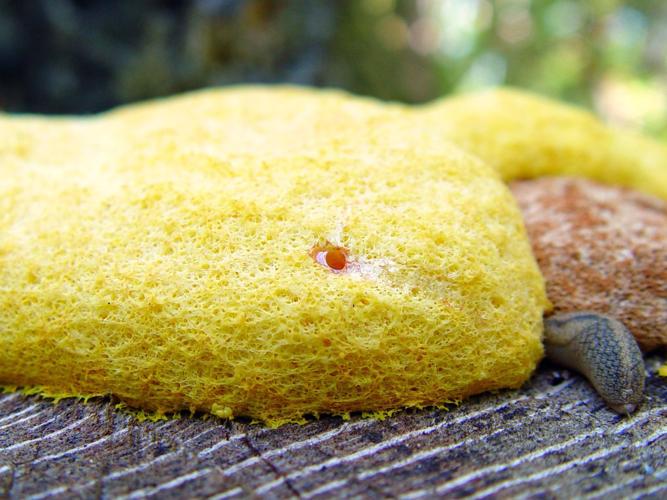
- By Peter L. Warren Special to the Arizona Daily Star
Question: After having a compost pile for a few years, I have noticed a number of large roaches in the area and at times a greenish yellow mold grows on the top of the compost. Is there some way I can control these two problems?
Answer: Cockroaches use compost as a food source and as a place to live. The same is true for the mold you see growing on the surface. They are probably not your favorite things to see in your compost, but they are both helping to decompose the pile, so they’re not all bad. Most people dislike cockroaches that like to live in our homes although my cats love them to death. Out in the wild, cockroaches are very helpful decomposers. The yellow mold you see is sometimes affectionately known as dog vomit slime mold because that’s what it looks like when you find it. By turning your compost over more frequently, you will disturb the life cycle of both these organisms and they will be less likely to colonize the area. You will also likely speed up the process of turning your compost into something usable.
Peter L. Warren is the Forest Health Program coordinator for the Arizona Department of Forestry and Fire Management. Questions, photos and videos may be emailed to tucsongardensage@gmail.com
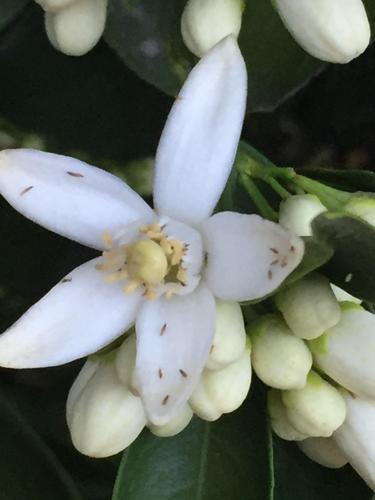
- By Peter L. Warren Special to the Arizona Daily Star
Question: We saw these little bugs/insects on our friend’s orange tree in Tucson — near the Oracle and River roads area — and wondered what they were, and if harmful or not. First saw them about three weeks ago, and last saw them (not so many) about a week ago.
Answer: These insects are called thrips. They can be pests when they feed on flower, fruit and leaf buds. Their feeding causes very small damaged areas but as the flowers, leaves and fruit grow, the areas become larger and appear as discoloration or distortion on the plant surface. Typically, we don’t recommend treating for them because the damage often occurs before we notice them and they don’t affect the taste of the fruit or the ability of the leaves to photosynthesize. If you were selling your fruit to a grocery store, it would be important to spray the trees because shoppers won’t often buy fruit that have scars on the rind.
Peter L. Warren is the Forest Health Program Coordinator for the Arizona Department of Forestry and Fire Management. Questions, photos and videos may be emailed to tucsongardensage@gmail.com

- By Peter L. Warren Special to the Arizona Daily Star
Question: I was at my doctor’s office and noticed a guy spraying pesticide on flowering plants with bees. I asked in the doctor’s office and they said the bees were flying around the door and bothering some of the patients as they came and went so they called this guy to spray the bees. Isn’t there another way to fix this besides killing the bees?
Answer: Yes, there is a way to fix it. The bees are attracted to nectar and pollen so you must remove the food source or they will return. Unfortunately, what sometimes happens is an uninformed client asks for help from a pesticide applicator that either can’t or isn’t willing to think critically about the situation. In this case, the applicator treated the symptom instead of the problem. He may have killed some bees but more will return later. Hopefully they will not continue to pay this applicator to kill more bees when they return. Pesticide applicators aren’t all this bad. Most applicators are trained to think about the entire landscape as an ecosystem and to watch out for non-target organisms, including beneficial insects like bees. This is a good teaching moment for the doctor office as well. Bees are not aggressive unless defending their home so their presence on flowers doesn’t necessarily equate to a dangerous situation. There are some pesticide applicators that are also beekeepers or at least have knowledge of bees and their behavior. I recommend seeking someone like this to deal with bee problems.
Peter L. Warren is the Forest Health Program Coordinator for the Arizona Department of Forestry and Fire Management. Questions, photos and videos may be emailed to tucsongardensage@gmail.com

- By Peter L. Warren Special to the Arizona Daily Star
Question: I am interested in identifying this unknown garden visitor. I originally ID’d it as a native bee but after closer inspection, I am not sure if this is a bee.
Answer: Your visitor is a bee mimic sometimes called a bee fly. It is a member of the fly order (Diptera) and the family Bombyliidae. As larvae, these insects are parasites of other insects. As adults, we generally see them feeding on nectar and pollen. They can’t harm humans and are not considered to be pests.
Peter L. Warren is the Forest Health Program Coordinator for the Arizona Department of Forestry and Fire Management. Questions, photos and videos may be emailed to tucsongardensage@gmail.com

- By Peter L. Warren Special to the Arizona Daily Star
Question: In the paper recently there was an article about blooming palo verde trees, and a claim that the reason for the bountiful flowers this year was due to additional carbon dioxide in the atmosphere. This struck me a totally ludicrous. My take is timely winter rains are the cause of bountiful flowers on any plant any year, not additional carbon dioxide!
Answer: In many plants the primary factors affecting flowering are day length, light intensity, temperature, soil moisture, and plant nutrition. Carbon dioxide in the atmosphere plays a critical role in photosynthesis and plant growth. If levels are too low, plant growth shuts down. In response to concerns about elevated carbon dioxide levels in the future associated with climate change, studies have been done to determine how these elevated levels will affect plant growth in the future. Some of this research found that plants grown at elevated carbon dioxide levels show earlier and higher production of flowers, fruits, and seeds. Keep in mind these studies were done at artificially elevated carbon dioxide levels . In the article you mentioned the quote from a local doctor said “The reason we see palo verdes become so lush is that there is more carbon dioxide in the atmosphere.”
Although we are currently experiencing the highest levels in many years, it would be difficult to show we had more flowers this year than last year based on increased levels of carbon dioxide. The more likely explanation is a combination of timely winter rains, as you mentioned, and a warm spring.
Peter L. Warren is the Forest Health Program Coordinator for the Arizona Department of Forestry and Fire Management. Questions, photos and videos may be emailed to tucsongardensage@gmail.com

- By Peter L. Warren Special to the Arizona Daily Star
Q: I have a big mesquite tree that we planted in our front yard about 30 years ago and it has looked good except for the mistletoe, which we trim off every year.
Now the bark is peeling off. Do you know why that’s happening and is here anything we can do to stop it?
A: Bark peeling is sometimes a sign of drought. We are in the midst of a 20-plus year drought and even tough mesquites will eventually succumb to that if not given supplemental water.
This is especially true of trees in our landscapes because they are often placed in situations where they would not grow naturally.
Peter L. Warren is the Forest Health Program Coordinator for the Arizona Department of Forestry and Fire Management. Questions, photos and videos may be emailed to tucsongardensage@gmail.com
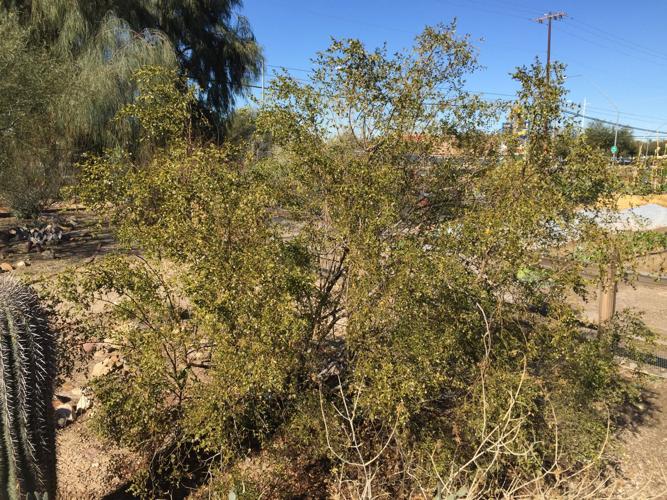
- By Peter L. Warren Special to the Arizona Daily Star
Q: My lot in Picture Rocks has lots of creosote plants, a couple of which I need to remove for access. I was wondering, since creosote used to be a wood preserver, is it safe to chip up the branches (for me and other plants in the yard) safe to compost and so on?
A: Yes, it is safe to use creosote as a mulch or compost. Once any trees and shrubs are chipped for mulch or ground up for compost, they are organic matter like any other plant and will eventually provide a slow release nitrogen source for your garden or landscape.
In the short term, mulch is a good way to moderate temperature extremes in root zones and maintain soil moisture a bit longer than bare soil.
Peter L. Warren is the Forest Health Program Coordinator for the Arizona Department of Forestry and Fire Management. Questions, photos and videos may be emailed to tucsongardensage@gmail.com

- By Peter L. Warren Special to the Arizona Daily Star
Q: A mesquite tree beside my driveway is getting new leaves, but I noticed a couple of dead branches among the greenery. They snapped off easily at a point where they appeared to have been neatly girdled. Does some kind of critter do that, and why?
A: Yes, the critter is commonly known as the mesquite twig girdler (Oncideres rhodostica). It is a long-horned beetle, about an inch long, that is native to our area and not considered to be a pest.
The female of the species does the girdling and then lays her eggs out beyond the girdle. The larvae feed on the nutritious cambium layer under the bark.
The nice way to think of this damage is as nature’s way of pruning your tree.
Peter L. Warren is the Forest Health Program Coordinator for the Arizona Department of Forestry and Fire Management. Questions, photos and videos may be emailed to tucsongardensage@gmail.com

- By Peter L. Warren Special to the Arizona Daily Star
Q: Seedpods drop from trees in the parking lot in front of the Target store in Oro Valley, but we have been unable to identify what kind of trees they are. Can you help?
Answer: Your seedpods are from the Australian bottle tree (Brachychiton populneus). This is a large evergreen shade tree that can reach 60 feet in height.
These trees do well in full sun in our arid environment with sufficient water. T
he seedpods are sometimes considered messy because they decay very slowly and can be numerous on the ground.
Peter L. Warren is the Forest Health Program Coordinator for the Arizona Department of Forestry and Fire Management. Questions, photos and videos may be emailed to tucsongardensage@gmail.com
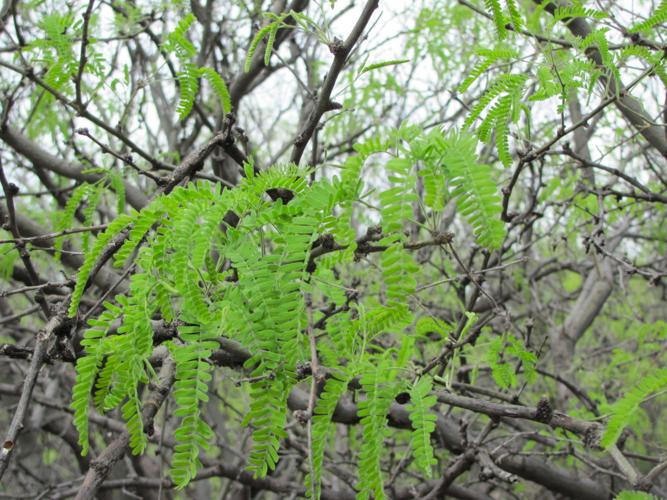
- By Peter L. Warren Special to the Arizona Daily Star
Q: We bought what we believe to be an Arizona mesquite around April of last year. It was transplanted right away and watered about once a week, as the nursery worker said it didn’t need much water.
Fast forward to around September or October and the leaves started to turn yellow and brown. New leaves were still growing, and they were coming in green.
During the winter the leaves fell and we’re still waiting for new leaves to grow.
After checking for green under the bark and seeing if the branches snap off, it seems as though the little tree is still alive — barely. Any tips on getting it to grow or how to keep it alive?
A: It seems you took care of the tree properly although I am not sure how much water you gave it. Mesquites normally shed some leaves in the fall but they also shed leaves if they are too dry. If your tree is still bare now, it may not have received enough water.
Assuming it is still alive, the best you can do is to water it properly. That means once every two to three weeks now that the tree is established. The water should reach a depth of 24 inches and drip irrigation around the root zone is best.
Peter L. Warren is the Forest Health Program Coordinator for the Arizona Department of Forestry and Fire Management. Questions, photos and videos may be emailed to tucsongardensage@gmail.com
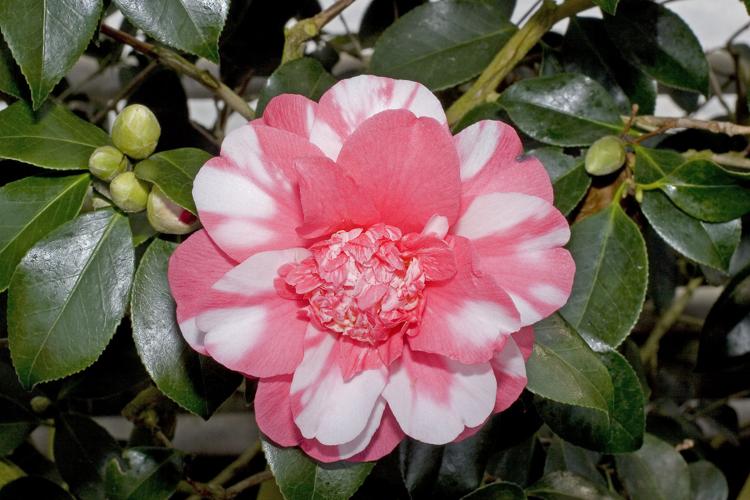
- By Peter L. Warren Special to the Arizona Daily Star
Q: I planted last November in a raised planter three of these camellias. Two of the three are dying. The leaves dried from the top down. There are still some leaves alive/pliable on the bottom of the shrub. The third camellia is doing well. They get morning sun and are shaded most of the rest of the day.
My local nursery told me to deep water them, as they don’t like our soil in Tucson. I am currently continuing to water once a week but more deeply. Is there any chance of saving them at this point?
A: Camellias are not ideal plants for the desert but you can grow them if you are careful. The soil here is too alkaline for these plants so they are best grown in containers or raised beds where you can keep the soil pH on the acidic side. They also need well-drained soil with a good amount of organic matter. They don’t survive in direct sun, which may partially explain the dried leaves. Even morning sun might be too much, depending on how long they are exposed. They do better in filtered shade and protected from western exposure as you are doing. The watering advice you received is correct in the amount if the soil is drying out that quickly, although watering does nothing to affect soil pH. Plants in containers and raised beds often dry out quicker than those planted in the ground so you might need to monitor the situation more closely to determine how often to water. Small containers often need water every day.
To save your remaining plant, I recommend you make sure it is not receiving too much sun, double check the soil moisture and adjust your irrigation accordingly, and amend the soil with sulphur to lower the pH as needed. Testing your soil at a reputable lab will help determine how much sulphur to add to reach the desired pH value.
Peter L. Warren is the Forest Health Program Coordinator for the Arizona Department of Forestry and Fire Management. Questions, photos and videos may be emailed to tucsongardensage@gmail.com
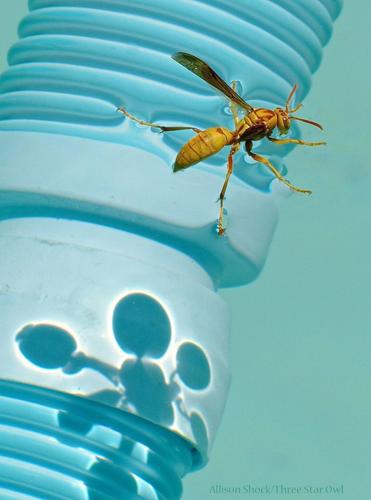
- By Peter L. Warren Special to the Arizona Daily Star
Q: For several weeks we have had what I call “golden wasps” flying around our house. On occasion two or three have made it into the house. They haven’t been aggressive, just flying around. Recently, we have noticed many of them trying to build a nest in our carport. The largest we have seen before getting rid of it has been about the size of a golf ball.
These insects have a distinctive wasp body, completely yellow (more of a golden yellow) and their wings are dark colored. We are for live-and-let-live with the wildlife in our area but we don’t think we want these guys living in the carport. Any suggestions would be most welcome.
A: Your golden wasps are paper wasps also known as Polistes flavus. They are members of the Vespidae family of wasps and not usually aggressive unless defending their nest. Their hanging paper nests are constructed each year using bits of bark and other similar material. These insects will make nests wherever they see a good site that protects their family from the environment and has nearby food sources.
It’s difficult to deter them without putting up screens to block their entrance so you might have to keep up the removal, at least in the early spring until they establish nests elsewhere. Because they nest on annual cycle the mated queens that overwintered nearby will typically stay with one nest until the end of the year, adding more cells to lay more eggs as their family grows. It’s good that you are fine with them living elsewhere because they are beneficial predators of some of our pest insects.
Peter L. Warren is the Forest Health Program Coordinator for the Arizona Department of Forestry and Fire Management. Questions, photos and videos may be emailed to tucsongardensage@gmail.com
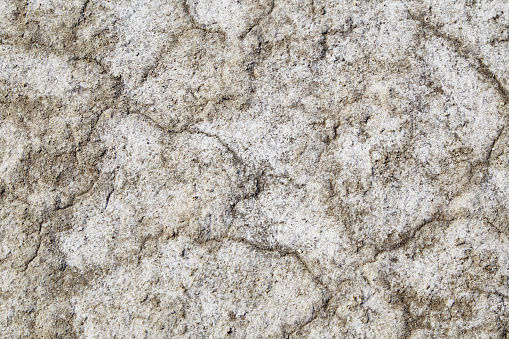
- By Peter L. Warren Special to the Arizona Daily Star
Q: We had a mountain laurel tree planted in March of 2016. Thought we followed the instructions for watering before leaving for Minnesota in May. While we were gone it was watered by the drip system. On our return in October the leaves were light green so took a sample to Civano Nursery and they said it showed that there was too much salt from not being watered deep enough. They recommended watering on a slow drip for ⅔ hours once a week, which we’ve been doing. The leaves are still pale green, not showing any improvement. Now we’re wondering if there’s any way to save the tree. Do you have any advice for us?
A: Given our salty soil and the salt contained in fertilizers, it is certainly possible your tree has an excess of salt in the root zone. A soil test would confirm this diagnosis but watering it deeply might confirm as well. The watering schedule they suggest is good for newly planted trees. Since your tree has been in the ground for a year, you can back it off a bit and water deeper. Established Texas mountain laurel trees should be watered deeply every two or three weeks to a depth of 24 to 36 inches to effectively wash the salt through the root zone. Because not all drip systems are created equal, it would be good to measure the water depth with a soil probe to make sure the running time is correct. A soil probe can be as simple as a piece of rebar that you push into the ground after irrigating to see how deep the water went. Dry soil will provide more resistance than the wet stuff and that’s how you will know when to pull out and measure the depth.
Peter L. Warren is the Forest Health Program Coordinator for the Arizona Department of Forestry and Fire Management. Questions, photos and videos may be emailed to tucsongardensage@gmail.com

- By Peter L. Warren Special to the Arizona Daily Star
Q: What can we do to save the life of our beloved cactus! It started in December with some of the brown spots and now it is spreading. It has always been protected for frost with Styrofoam cups on tips and a burlap wrap. We have noticed other cacti (Mexican Fence Post) here in Saddlebrooke have the same markings. Any help would be greatly appreciated.
A: Brown spots on cacti may be caused by a few different things including too much sun on newly planted cacti, damage from animals, frost, hail, some pesticides, and diseases. The spots on your cacti appear to be fungal lesions that sometimes occur when we have cool, wet weather as we did this winter. The damage is usually cosmetic and won’t cause the death of the plant but it is also irreversible so it will remain as a scar. Now that summer-like weather has begun you should see less of this disease occurring in your neighborhood.
Q: We had a mountain laurel tree planted in March of 2016. Thought we followed the instructions for watering before leaving for Minnesota in May. While we were gone it was watered by the drip system. On our return in October the leaves were light green so took a sample to Civano Nursery and they said it showed that there was too much salt from not being watered deep enough. They recommended watering on a slow drip for ⅔ hours once a week, which we’ve been doing. The leaves are still pale green, not showing any improvement. Now we’re wondering if there’s any way to save the tree. Do you have any advice for us?
A: Given our salty soil and the salt contained in fertilizers, it is certainly possible your tree has an excess of salt in the root zone. A soil test would confirm this diagnosis but watering it deeply might confirm as well. The watering schedule they suggest is good for newly planted trees. Since your tree has been in the ground for a year, you can back it off a bit and water deeper. Established Texas mountain laurel trees should be watered deeply every two or three weeks to a depth of 24 to 36 inches to effectively wash the salt through the root zone. Because not all drip systems are created equal, it would be good to measure the water depth with a soil probe to make sure the running time is correct. A soil probe can be as simple as a piece of rebar that you push into the ground after irrigating to see how deep the water went. Dry soil will provide more resistance than the wet stuff and that’s how you will know when to pull out and measure the depth.
Peter L. Warren is the Forest Health Program Coordinator for the Arizona Department of Forestry and Fire Management. Questions, photos and videos may be emailed to tucsongardensage@gmail.com

- By Peter L. Warren Special to the Arizona Daily Star
Q: I wrote earlier in the week about those pesky bugs that attack our Texas mountain laurel every year, and they have already started attacking this year. I am including a photo of the critter so that you might recommend something specific to get rid of them. There are too many to hand pick and they move really fast when trying to get away.
A: The critter is Uresiphita reversalis, aka the genista caterpillar. They typically feed on new growth at the ends of branches on Texas mountain laurel. I recommend a spray of Bt (Bacillus thuringiensis) where they are feeding. Bt is a naturally occurring soil bacterium that causes disease in certain insects. Bt is considered ideal for pest management because of its specificity and because of its lack of toxicity to humans or the natural enemies of many plant pests. There are different strains of Bt, each with specific toxicity to particular types of insects so be sure to choose the strain that is labeled for caterpillar pests.
Peter L. Warren is the Forest Health Program Coordinator for the Arizona Department of Forestry and Fire Management. Questions, photos and videos may be emailed to tucsongardensage@gmail.com
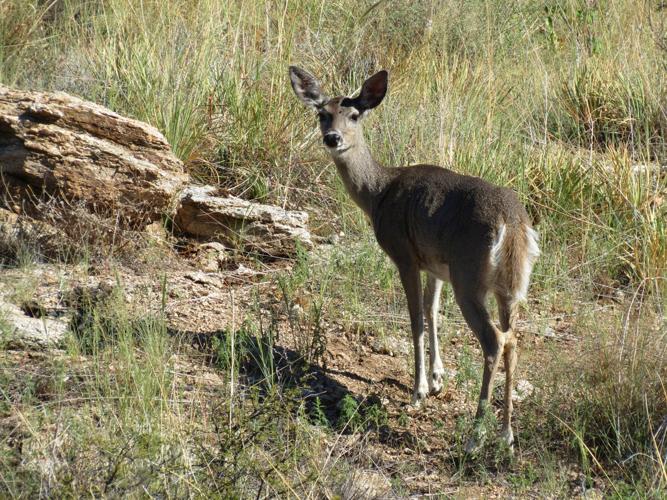
- Peter L. Warren Special to the Arizona Daily Star
Q: I have a problem with deer entering our yard and eating the flowers in our patio container pots. I have tried a spray-on repellent, but it hasn’t worked. A fence is not possible. Any suggestions?
A: Fencing is the gold standard for protecting plants from deer. Otherwise, it is a bit more of a challenge. Some people use repellents with limited success because the deer either get used to the smell or the repellent wears off. If you want to try other repellents, some people hang small cloth bags with fragrant soap in them from outside branches. Others use various types of predator urine. You could also get a big dog that will bark at the deer as needed. Another tactic is to alter your landscape so the plants are difficult to access. This might be accomplished by putting the containers behind something else that blocks the deer. If there is enough other food nearby, they may see it’s too much trouble and change their route.
Peter L. Warren is the Forest Health Program Coordinator for the Arizona Department of Forestry and Fire Management. Questions, photos and videos may be emailed to tucsongardensage@gmail.com
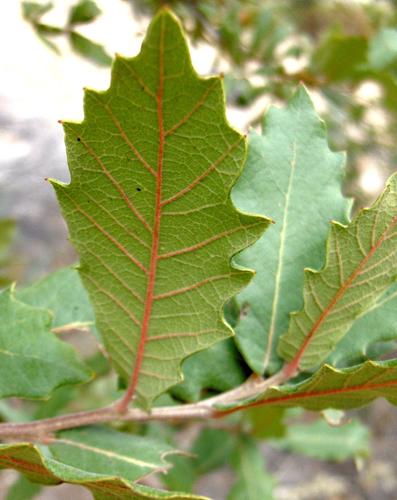
- Peter L. Warren Special to the Arizona Daily Star
Q: We are contemplating purchasing a home in Green Valley. There is a beautiful white oak in the front yard about 15 feet away from the home. There is a root lifting the brick pavers. How or what should I do to make sure the roots aren’t going under the foundation. Also, could I dig up that root and cut it so it doesn’t do any more damage, without hurting the tree?
A: The Arizona white oak (Quercus arizonica) is a beautiful tree, but unfortunately someone planted it too close to the house. The mature size of that species can be as wide as 50 feet. The problem you described could get worse as the tree matures. You should probably hire a certified arborist to take a look at the tree and determine the gravity of the situation. Some companies have an air spade to temporarily blow away the surface soil to get a better sense of where the roots are and which ones are expendable, if any. Some roots are critical to the stability of the tree so you wouldn’t want to cut away one that is preventing the tree from falling over.
Peter L. Warren is the Forest Health Program Coordinator for the Arizona Department of Forestry and Fire Management. Questions, photos and videos may be emailed to tucsongardensage@gmail.com
- Peter L. Warren Special to the Arizona Daily Star
Q: I use Jobe spikes to fertilize my fruit and nut trees. Last year I fertilized in mid-February and when I went to fertilize again at the end of May, I noticed the February spikes were not used up. I use drip irrigation and put the spikes near the emitters. How long do I need to wait between refertilizing with the spikes?
A: It depends. Fertilizers in a solid spike or granular form are going to dissolve as a result of exposure to water and warm temperatures. The manufacturer typically recommends applying them at the drip line of your trees so that rain falling off the tree or drip irrigation properly installed there will help dissolve the fertilizer. If we have a cooler spring or not much winter rain, it’s possible the spikes will last longer than advertised. Also, you probably don’t need to fertilize throughout the year. Mature trees don’t need much fertilizer and they are able to get many nutrients from the soil. A late winter application will likely suffice for the year.
Peter L. Warren is the Forest Health Program Coordinator for the Arizona Department of Forestry and Fire Management. Questions, photos and videos may be emailed to tucsongardensage@gmail.com
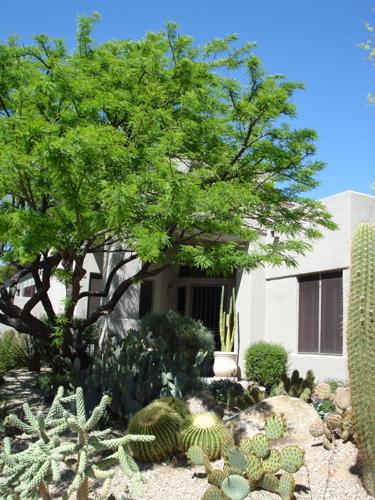
- By Peter L. Warren Special to the Arizona Daily Star
Q: I have an area about 15 feet by 12 feet that is bordered on two sides by sidewalk on the south side of my house. I have an 8-year-old thornless mesquite tree planted in this area. I am worried about the possibility of the roots damaging the sidewalks. Should I remove this tree? If I do, what type of tree would you recommend for that size area that would not harm the sidewalks? This area is next to my front patio and I would like to have some shade for it.
A: Thornless mesquite trees are a South American hybrid also known as the Chilean mesquite. The mature size of this tree is approximately 30 feet by 30 feet and that is only the above-ground size. The roots may spread twice as far, so your sidewalk is in jeopardy.
Small trees that could fit this space include kidneywood, Texas mountain laurel, Arizona rosewood, little leaf ash, and leather-leaf acacia. These may not give the shade you desire.
A few slightly larger trees that might fit are Texas ebony, palo blanco, and cascalote. I am sure there are others, so it would be good to visit our local nurseries to see what they have available.
Peter L. Warren is the Forest Health Program Coordinator for the Arizona Department of Forestry and Fire Management. Questions, photos and videos may be emailed to tucsongardensage@gmail.com
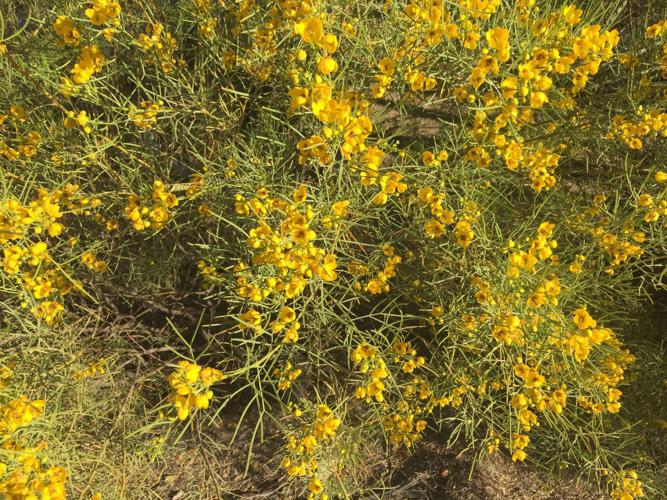
- By Peter L. Warren Special to the Arizona Daily Star
Q: I have three of these in my yard, plus three that came up recently in disturbed ground. What is it?
A: Your plants are called Senna phyllodinea, or desert Senna or silver leaf cassia. It is native to Australia and does well here. It can propagate by seed. The slender silver leaves are a good desert adaptation for reflecting the sun and reducing exposure to it. They can grow into a large shrub of 6 feet by 6 feet if allowed. The fragrant yellow flowers in February are a welcome sight for many.
Peter L. Warren is the Forest Health Program Coordinator for the Arizona Department of Forestry and Fire Management. Questions, photos and videos may be emailed to tucsongardensage@gmail.com
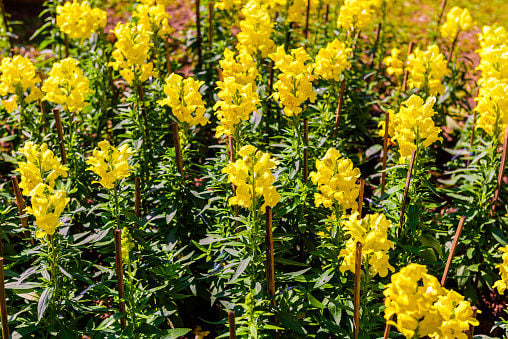
- By Peter L. Warren Special to the Arizona Daily Star
Q: Some of my snapdragons are covered with dark spots and it seems to be spreading to neighboring plants. What can I do to stop this problem?
A: From examining your plant sample, the problem is a disease called snapdragon rust that is caused by the fungus Puccinia antirrhini. This is a widespread pathogen that has been around since the 1800s. Small, yellow spots on the leaves are the first indication. Unless you are paying close attention, you won’t notice the yellow spots until they mature into chocolate-brown pustules. The spores that emerge from these pustules are spread by wind mostly but also possibly by rain and insects. The infection and incubation of these spores occurs best when temperatures are between 50 and 75 degrees, and that is what we have been experiencing in recent weeks.
Once temperatures exceed 90 degrees or so, the spores cannot survive. Infested plants can be removed and destroyed to reduce the immediate source of spores. There are also fungicides available to manage the rust if removing the plants isn’t in the plan. Look for products labeled for managing rust on landscape plants. Rust-resistant varieties of snapdragons are available. Planting them with space between to allow for air circulation is helpful, as is making sure to use drip irrigation rather than overhead sprinklers.
Peter L. Warren is the Forest Health Program Coordinator for the Arizona Department of Forestry and Fire Management. Questions, photos and videos may be emailed to tucsongardensage@gmail.com
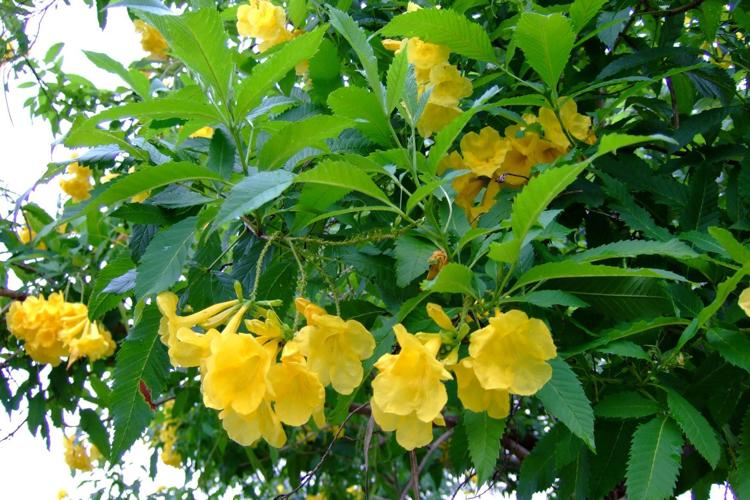
- By Peter L. Warren Special to the Arizona Daily Star
Q: I live in Tucson. Alkaline soil, lots of sun, not much rain. I have found contradictory info on fertilizing Tecomas. Local websites either say “responds well to regular fertilizer,” “fertilize with ammonium sulfate” or “this plant particularly hates (fertilizer).” Does anyone have a decisive answer from a reliable source?
A: Tecoma stans, aka yellow bells, has a reputation as a tough plant that needs little help once established, except for occasional pruning and pest management. Although I couldn’t find any research detailing its exact needs, all plants need water and nutrients.
If you want to have your soil tested by a laboratory, many of them will make fertilizer recommendations based on the results and which plants you are planning to grow. If you would rather experiment without a soil test, I recommend a slow release tree and shrub fertilizer in the spring and also recommend regularly scheduled drip irrigation every two or three weeks unless it is raining.
You can use composted manure or another organic material that has been composted as a slow-release fertilizer. In the end, your plants will help you figure out their needs by how well they appear and grow. For example, plants that begin to have yellow leaves with green veins are often showing a sign of nutrient deficiency. Taking a look at your landscape plants once a week or so to see if problems are occurring is one of the cornerstones of integrated pest management and a great way to catch problems before they get out of hand.
Peter L. Warren is the Forest Health Program Coordinator for the Arizona Department of Forestry and Fire Management. Questions, photos and videos may be emailed to tucsongardensage@gmail.com
View this profile on Instagram#ThisIsTucson 🌵 (@this_is_tucson) • Instagram photos and videos
Most viewed stories
-
50 fun events happening in Tucson this weekend Nov. 7-10 🧵🎞
-
Tucson is now home to the largest outdoor mural in the state 🎨
-
Tucson tattoo artist inked into the spotlight as contestant on 'Ink Master' season 16
-
34 FREE events happening in Tucson this November 2024 💸
-
Turkey and pie: where to get free Thanksgiving dinners this month
-
A giant list of restaurant patios in Tucson: brunch, fine dining and more
-
100 fun events happening this November 2024 🦖🎨
-
10 beautiful photos from Sunday's All Souls Procession ❤️
-
Cream filled croissants and crookies: the pastries at Café Francais are no joke
-
Fabulous science: this burlesque show combines glamour, dance and STEM



